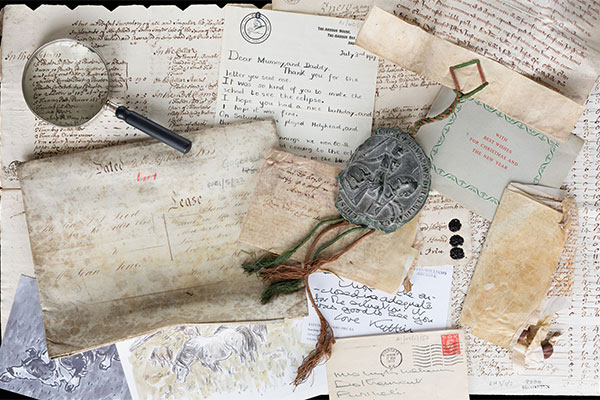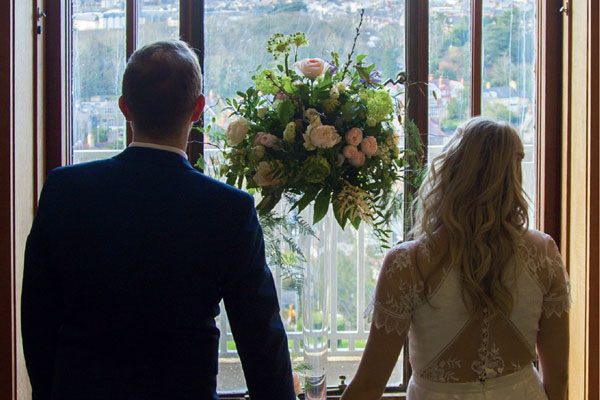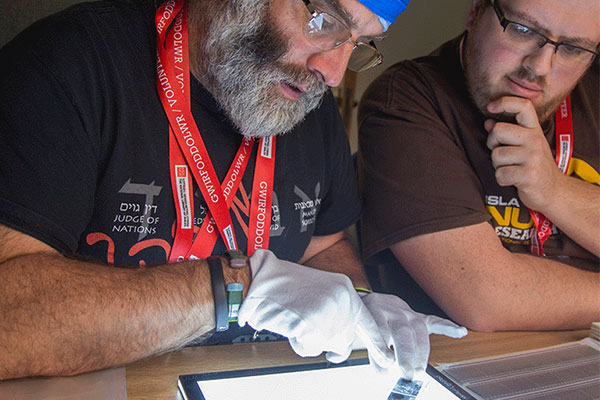This blog is part of a series to accompany the Wales to the World: maps from the National Library of Wales exhibition, currently on display at the Riverside Gallery, Haverfordwest, until 24 February 2024. Each blog will focus on a selection of items joined by a common theme. This time we are focusing on maps for learning and play.
Games have long been used to help children get to grips with geography. Jigsaw puzzles were first invented as a map teaching aid. They invention is generally attributed to John Spilsbury in the 1760s Originally, the pieces were not the ubiquitous shape of puzzles today, but were individually cut out along outlines of countries, or counties. Children could then piece together a complete map. In the exhibition, you can see a jigsaw, or ‘dissected map’ as they were originally known, from the 1890s. It was manufactured by William Peacock, a prolific creator of map jigsaws. His company, Peacock & Co., continued into the 1930s, when it was bought by Chad Valley.

Peacock & Co. were not cartographers, they used maps that were already available, pasted them onto wooden boards and then cut out the pieces. This puzzle is made up of the counties of England and Wales. Ideally, each county would have its own piece, but as each puzzle had to be laboriously and expensively hand cut, some pieces cover more than one county. Like jigsaws everywhere, this puzzle is missing a single piece!
Also on display is a school atlas used at Llanddewi Brefi Board School in the early 20th century. We know this because schoolgirl Mary Davies wrote her name and school on the cover. This book was designed to introduce the concept of a map to school children. The atlas opens with a drawing of a typical Victorian school building in an idyllic landscape of fields and rolling hills, a steam train passing in the background. The same scene is then shown on a map, all features carefully labelled. This would have helped school children get to grips with cartographic conventions by connecting them to a familiar landscape.
Most of the maps in the atlas focus on physical geographical features, but it also includes one historical map, showing ‘the Holy Land in the time of our saviour’, showing the embeddedness of religion in the general school curriculum at the time. The Middle East also appears in one of the Welsh language maps in the exhibition.
Published in 1916, Map y rhyfel yng ngwledydd y Beibl [Map of the war in the lands of the Bible] was intended to help ordinary people understand the course of the First World War by showing the modern placenames alongside their Biblical equivalents. The map was published in Y Darian, a radical South Wales paper. The map’s creator, Beriah Gwynfe Evans, explained his aims to a Darian reporter:
“Gwyr pobl Cymru eu Beibl, a’r enwau Beiblaidd-ond ni ch’eir ond ychydig o’r enwau hynny yn y papurau new- ydd, gan fod yr enwau diweddar ar y lleoedd yn wahanol i’r enwau a geir ar y lleoedd hynny yn y Beibl … Gwyr blant yr Ysgol Sul am Sardis, a Philadelphia, ac Elath, Ninifeh – ond pwy ohonynt a gysylltai yr enwau hynny ag ‘Aktisar,’ ‘Alashei,’ ‘Akaba,’ a ‘Mosul’, er engraifft. … A cha’r Cymro ddidordeb newydd wrth ddarllen hanes y brwydro yn y lleoedd dieithr hyn pan wel mai yr un ydynt a’r lleoedd y dysgwyd ef am danynt o dan ryw enw arall yn yr Ysgol Sul.” (Y Darian, 31 Awst 1916)
“The people of Wales know their Bible, and the Biblical names, but only a few of those names appear in the newspapers, as the current names of the places are different from the names found in the Bible … Sunday School children all know about Sardis, Philadelphia, Elath and Nineveh, but who can connect them to Aktisar, Alashei, Akaba and Mosul … the Welshman will have a new interest when reading the history of the fighting in these strange places when he sees that they are the same as the places he was taught about under some other name in Sunday School” (Y Darian, 31 August 1916)
The paper later published a letter of thanks from a Pembrokeshire woman who was keeping track of her cousins in Egypt using their letters and the Darian map.

To end on a lighter note, also on display are three map playing cards created by William Redmayne in the late 17th century. At the time, England and Wales together were made up of 52 counties – the same number of cards in a standard playing card deck. Several different publishers took advantage of this to make packs of cards where each county appeared on a different card. The ‘Pembrook-shire’ card here is from the first edition of Redmayne’s cards and dates to 1676. The cards were printed in black and white, and the red suit shapes were hand stamped after printing.
The following year, Redmayne released a revised second edition. Possibly the fact that Pembrokeshire is described as adjacent to Flintshire contributed to the decision to reprint! The second edition was also produced in black and white, with the expensive second stage of hand stamping the suits dispensed with. ‘Red’ and ‘black’ suits are distinguished by stripes and hatching respectively. The ‘Cardigan-shire’ and ‘Caernarvan-shire’ cards here are from this second edition.

These are just a few of the items on display in the Wales to the world exhibition, currently on display at the Riverside, Haverfordwest, until 24 February 2024.
Ellie King
Assistant Map Curator
Category: Article







